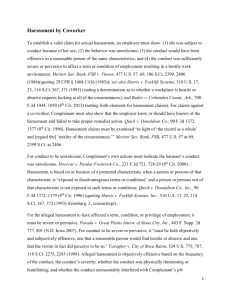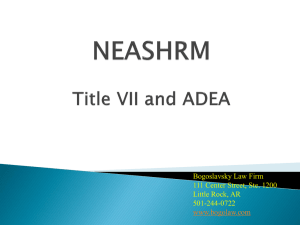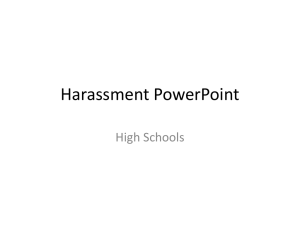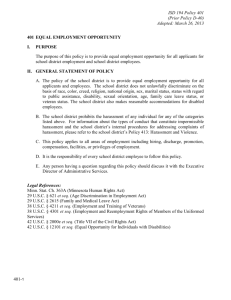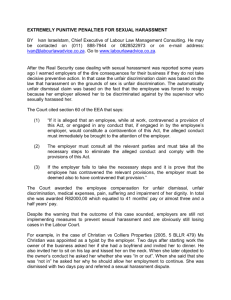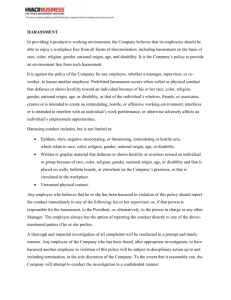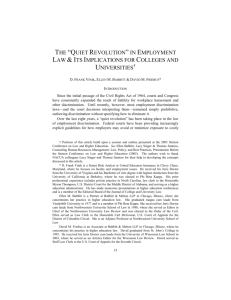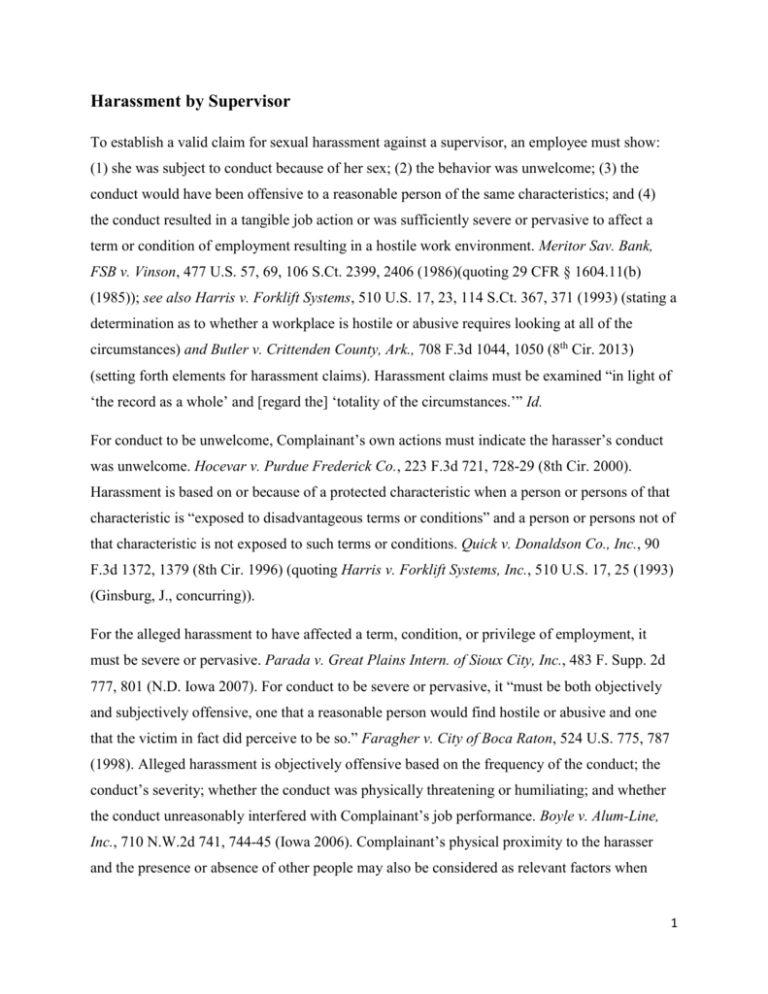
Harassment by Supervisor
To establish a valid claim for sexual harassment against a supervisor, an employee must show:
(1) she was subject to conduct because of her sex; (2) the behavior was unwelcome; (3) the
conduct would have been offensive to a reasonable person of the same characteristics; and (4)
the conduct resulted in a tangible job action or was sufficiently severe or pervasive to affect a
term or condition of employment resulting in a hostile work environment. Meritor Sav. Bank,
FSB v. Vinson, 477 U.S. 57, 69, 106 S.Ct. 2399, 2406 (1986)(quoting 29 CFR § 1604.11(b)
(1985)); see also Harris v. Forklift Systems, 510 U.S. 17, 23, 114 S.Ct. 367, 371 (1993) (stating a
determination as to whether a workplace is hostile or abusive requires looking at all of the
circumstances) and Butler v. Crittenden County, Ark., 708 F.3d 1044, 1050 (8th Cir. 2013)
(setting forth elements for harassment claims). Harassment claims must be examined “in light of
‘the record as a whole’ and [regard the] ‘totality of the circumstances.’” Id.
For conduct to be unwelcome, Complainant’s own actions must indicate the harasser’s conduct
was unwelcome. Hocevar v. Purdue Frederick Co., 223 F.3d 721, 728-29 (8th Cir. 2000).
Harassment is based on or because of a protected characteristic when a person or persons of that
characteristic is “exposed to disadvantageous terms or conditions” and a person or persons not of
that characteristic is not exposed to such terms or conditions. Quick v. Donaldson Co., Inc., 90
F.3d 1372, 1379 (8th Cir. 1996) (quoting Harris v. Forklift Systems, Inc., 510 U.S. 17, 25 (1993)
(Ginsburg, J., concurring)).
For the alleged harassment to have affected a term, condition, or privilege of employment, it
must be severe or pervasive. Parada v. Great Plains Intern. of Sioux City, Inc., 483 F. Supp. 2d
777, 801 (N.D. Iowa 2007). For conduct to be severe or pervasive, it “must be both objectively
and subjectively offensive, one that a reasonable person would find hostile or abusive and one
that the victim in fact did perceive to be so.” Faragher v. City of Boca Raton, 524 U.S. 775, 787
(1998). Alleged harassment is objectively offensive based on the frequency of the conduct; the
conduct’s severity; whether the conduct was physically threatening or humiliating; and whether
the conduct unreasonably interfered with Complainant’s job performance. Boyle v. Alum-Line,
Inc., 710 N.W.2d 741, 744-45 (Iowa 2006). Complainant’s physical proximity to the harasser
and the presence or absence of other people may also be considered as relevant factors when
1
assessing a sexual harassment claim. E.E.O.C. v. CRST Van Expedited, 679 F.3d 657, 686-87 (8th
Cir. 2012) (citing Carter v. Chrysler Corp., 173 F.3d 693, 702 (8th Cir. 1999)).
Conduct must be based on a protected characteristic; Title VII is not a general civility code for
the American workplace. Thorn v. Amalgamated Transit Union, 305 F.3d 826, 831 (8th Cir.
2002). Ostracism and rudeness by supervisors and co-workers do not rise to the level of an
adverse employment action. Id.
If the harasser is a supervisor, liability is imputed to the employer directly and the burden shifts
to the employer to prove it had an effective anti-harassment policy and the employee failed to
reasonably avail him or herself of it. See, generally, Faragher v. City of Boca Raton, 524 U.S.
775 (1998), and Burlington Industries, Inc. v. Ellerth, 524 U.S. 742 (1998). An employee is a
supervisor for purposes of a Title VII harassment claim “if he or she is empowered by the
employer to take tangible employment actions against the victim.” Vance v. Ball State Univ., -U.S. ---, 133 S.Ct. 2434, 2439 (2013). This includes an individual who makes recommendations
regarding tangible employment actions. Id. at 2452. In cases where the harassing employee has
no independent authority to take tangible job actions against the victim, the employee is
nevertheless a “supervisor” when the employee has substantial input into tangible employment
actions. Id. (citing Rhodes v. Illinois Dept. of Transp., 359 F.3d 498, 509 (7th Cir. 2004)
(Rovner, J., concurring in part and concurring in judgment)). Harassers necessarily have
substantial input into tangible employment actions if they are the people most familiar with the
victims’ work. Id. (citing Rhodes, 359 F.3d at 509 (Rovner, J., concurring in part and concurring
in judgment)). “Under those circumstances, the employer may be held to have effectively
delegated the power to take tangible employment actions to the employees on whose
recommendations it relies.” Id.
Because Complainant has alleged harassment by a supervisor not involving a tangible job action,
Respondent has a two-pronged affirmative defense available. First, it must show it exercised
reasonable care to prevent and promptly correct any harassment. Secondly, it must show the
employee unreasonably failed to take advantage of any preventative or corrective opportunities
provided by the employer or otherwise avoid harm. See, generally, Burlington Industries, Inc. v.
Ellerth, 524 U.S. 742 (1998) and Faragher v. City of Boca Raton, 524 U.S. 775 (1998). The first
prong generally requires an employer to establish, disseminate, and enforce a harassment policy
2
and complaint procedure. Hardage v. CBS Broad., Inc., 427 F.3d 1177, 1185 (9th Cir. 2005),
cert. denied, 549 U.S. 812 (2006).
When applying the correction prong, “the employer's notice of the harassment is of paramount
importance.” Madray v. Publix Supermarkets, Inc., 208 F.3d 1290, 1299 (11th
Cir. 2000)
(quoting Dees v. Johnson Controls World Servs., 168 F.3d 417, 422 (11th Cir. 1999)); see also
Stuart v. General Motors Corp., 217 F.3d 621, 633 (8th Cir. 2000) (stating, “Factors the [c]ourt
may consider when assessing the reasonableness of [an employer's] remedial measures include
the amount of time elapsed between the notice of harassment, which includes but is not limited
to a complaint of sexual harassment, and the remedial action ....”).
3

